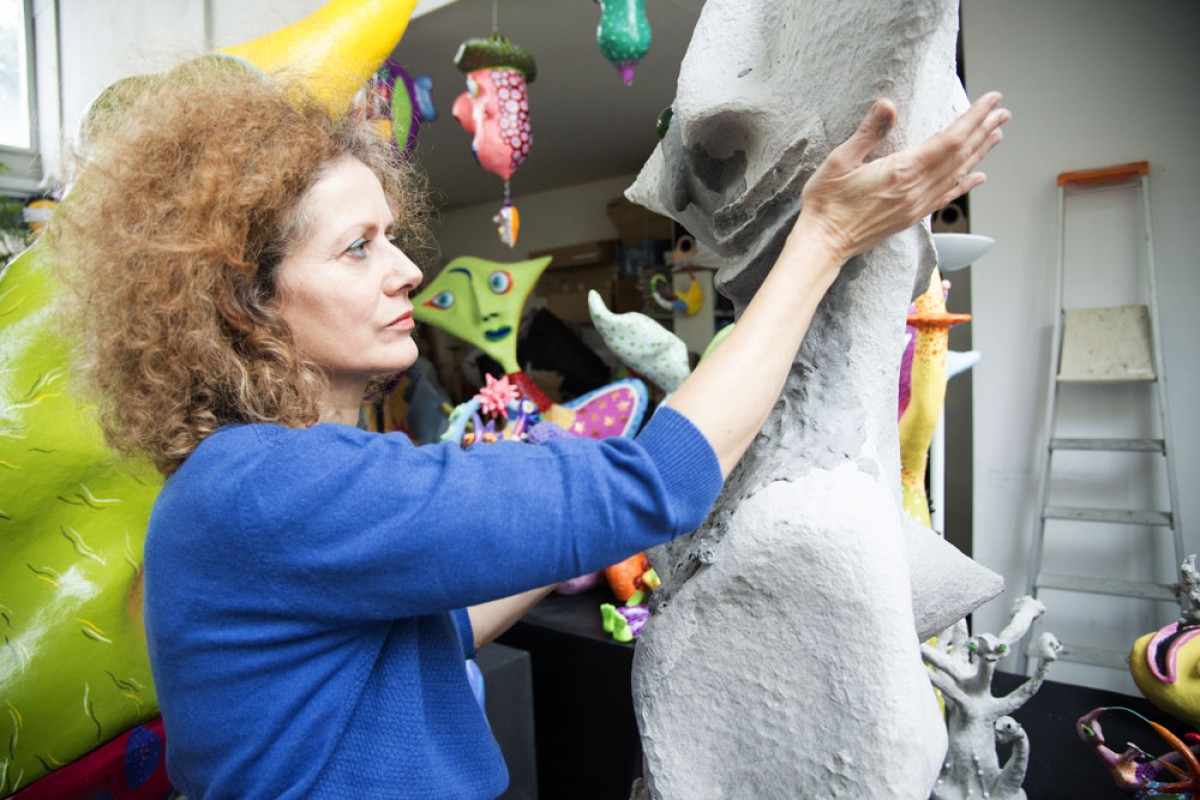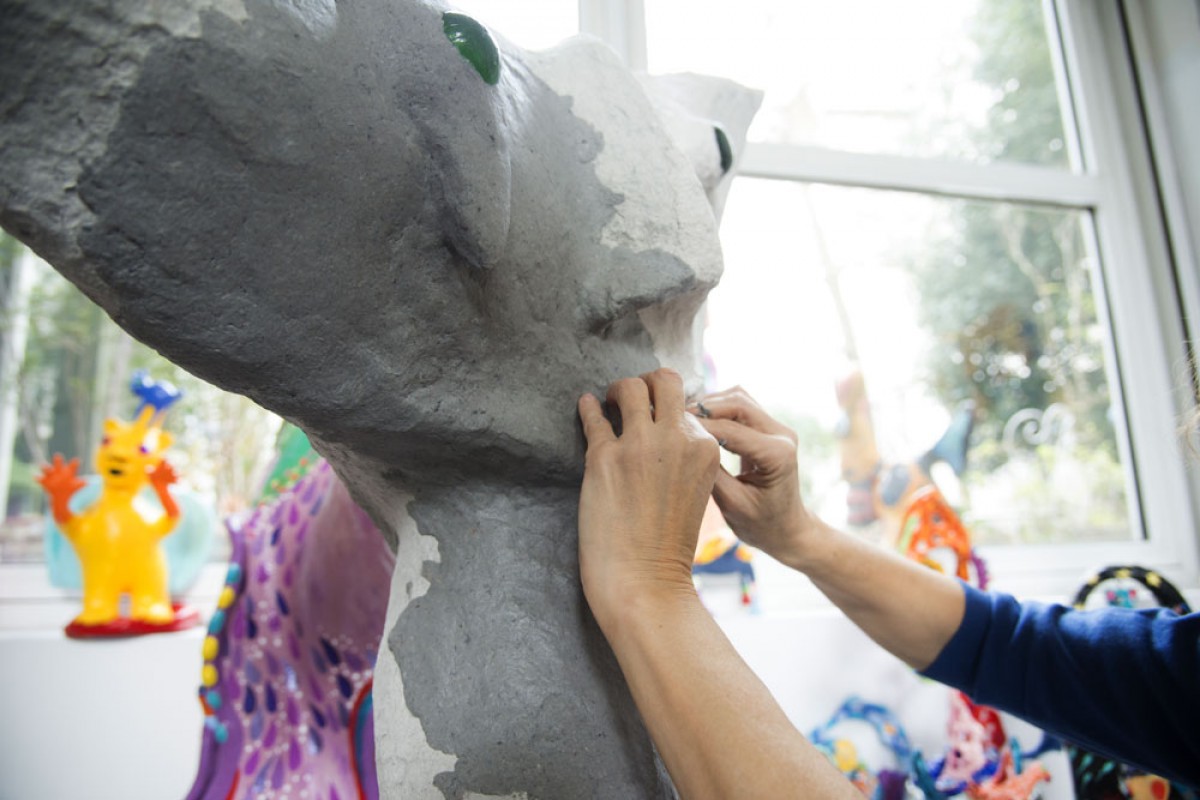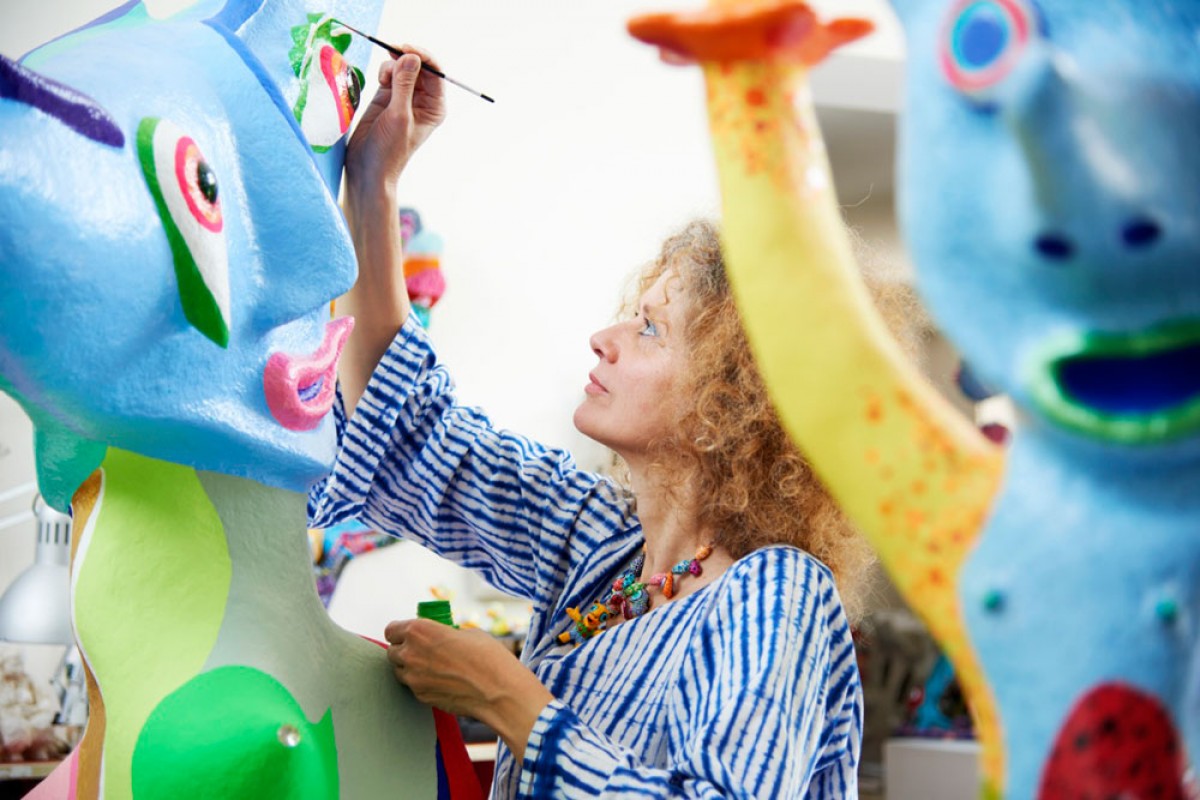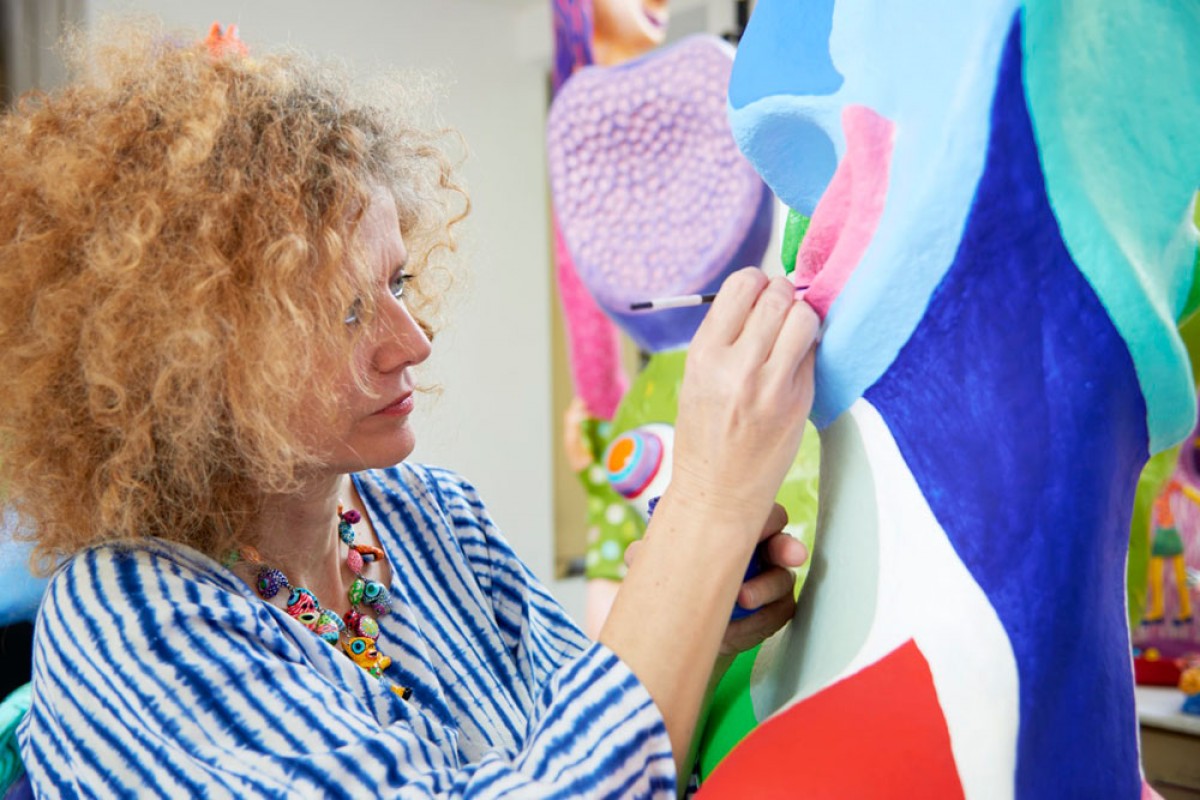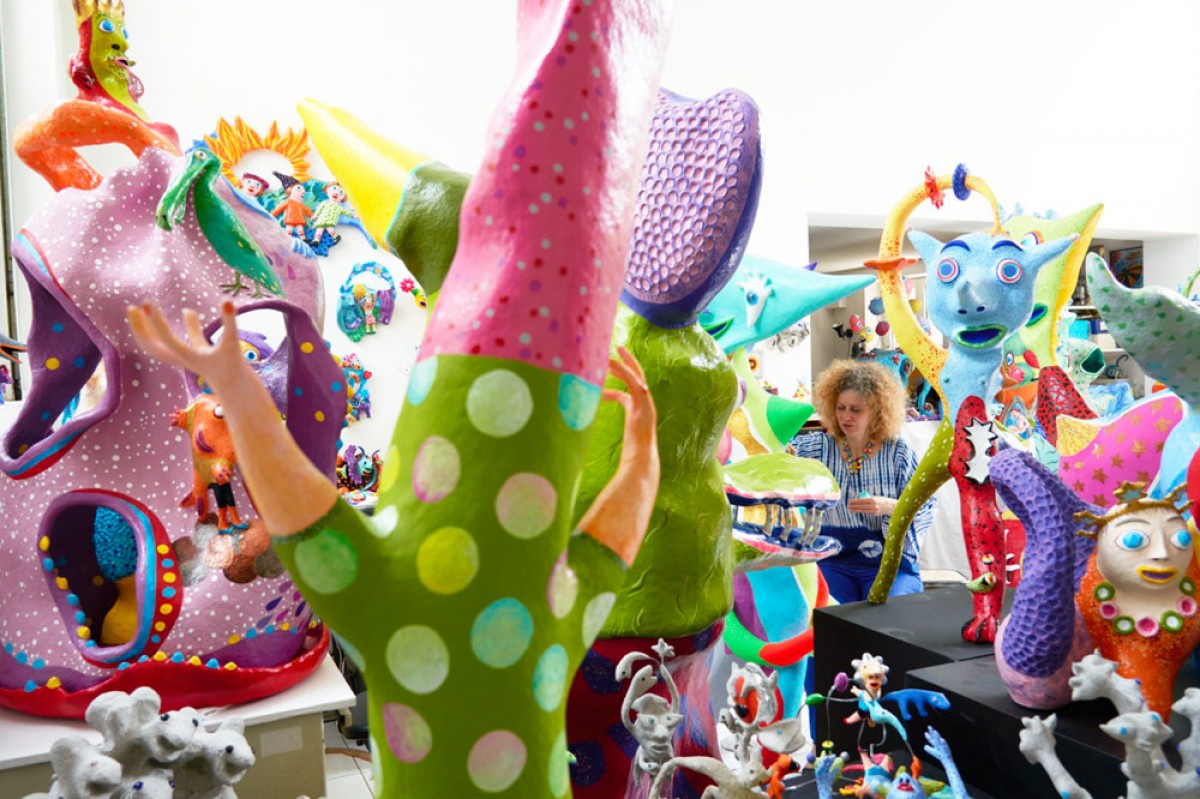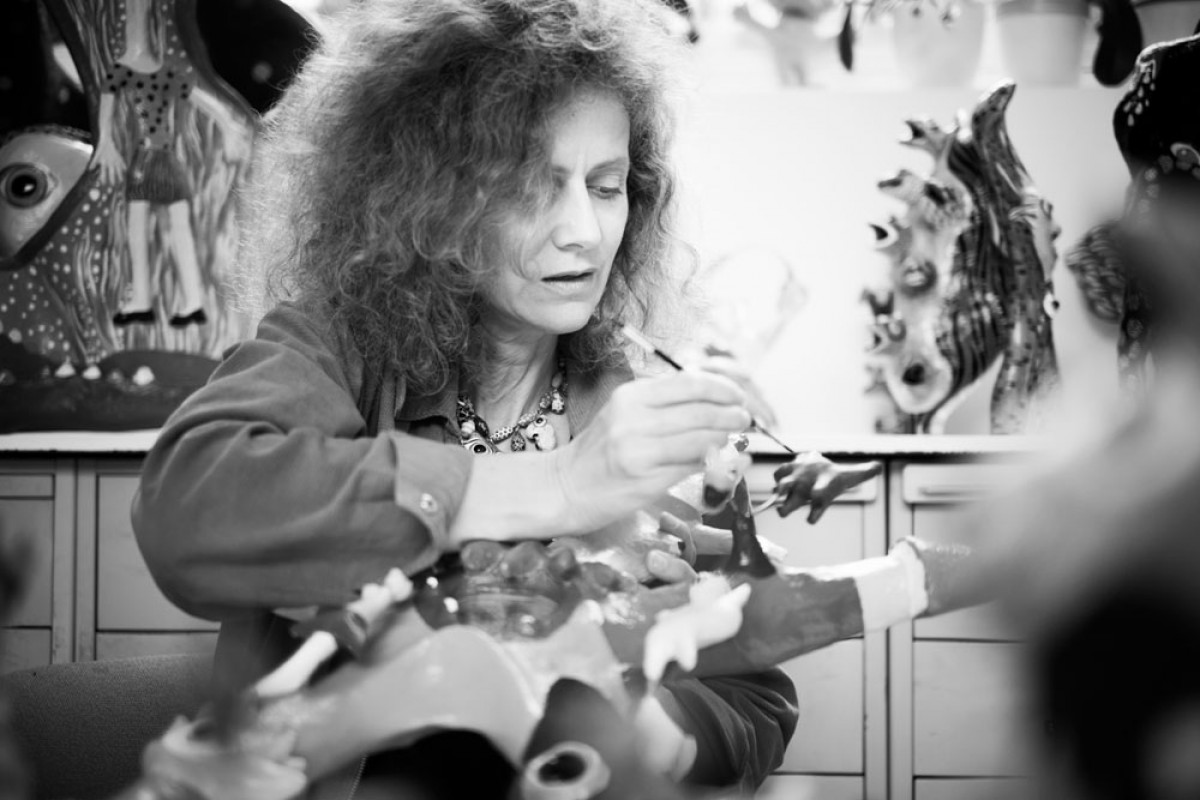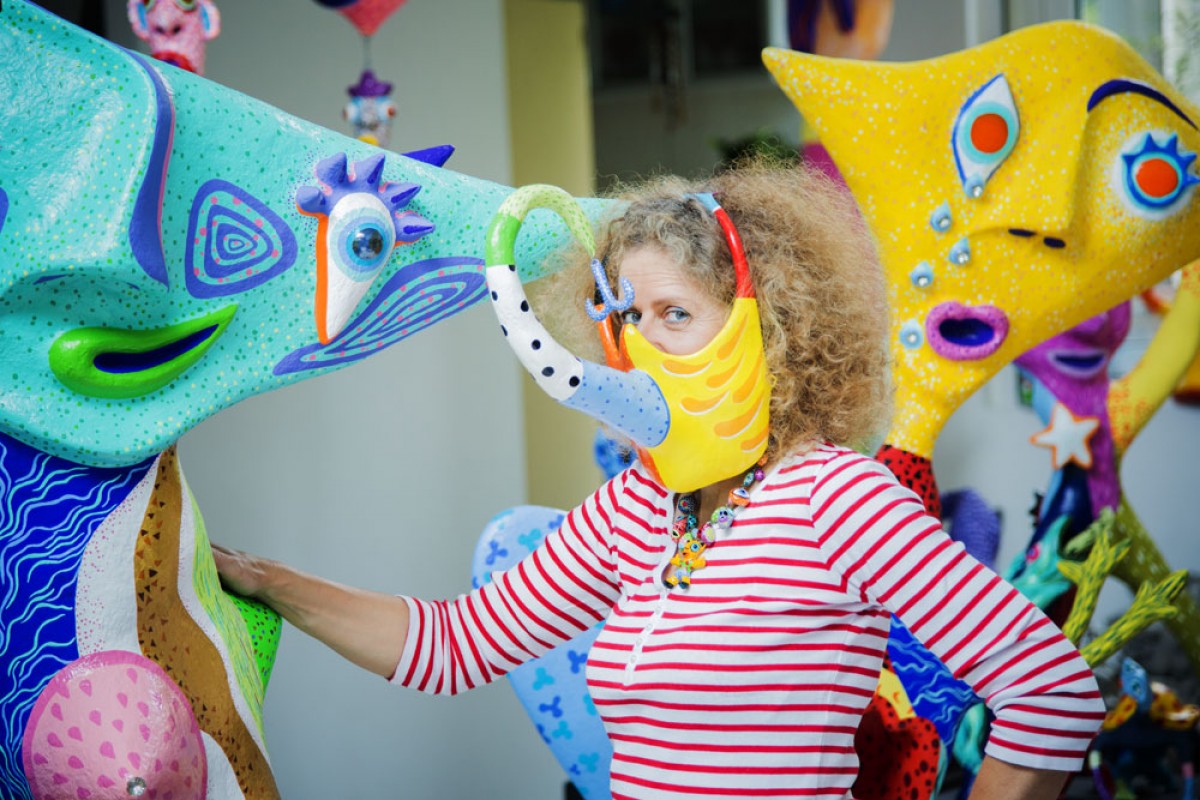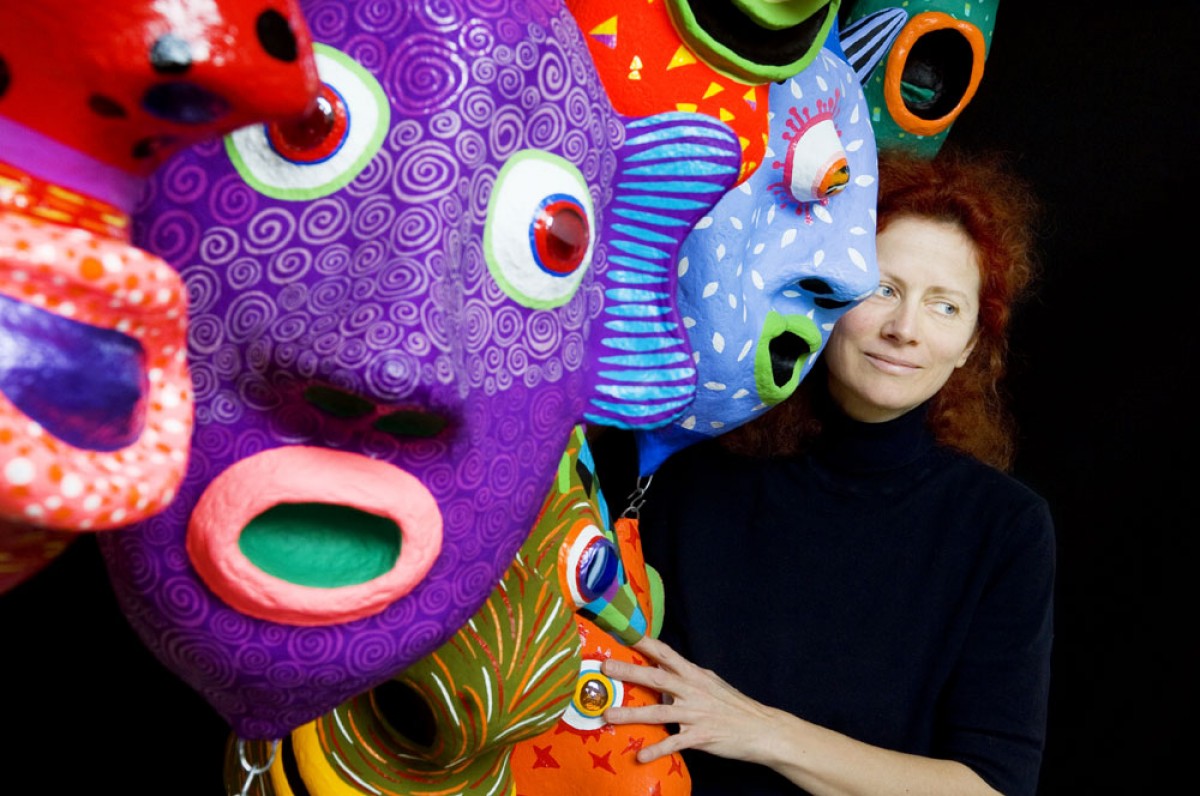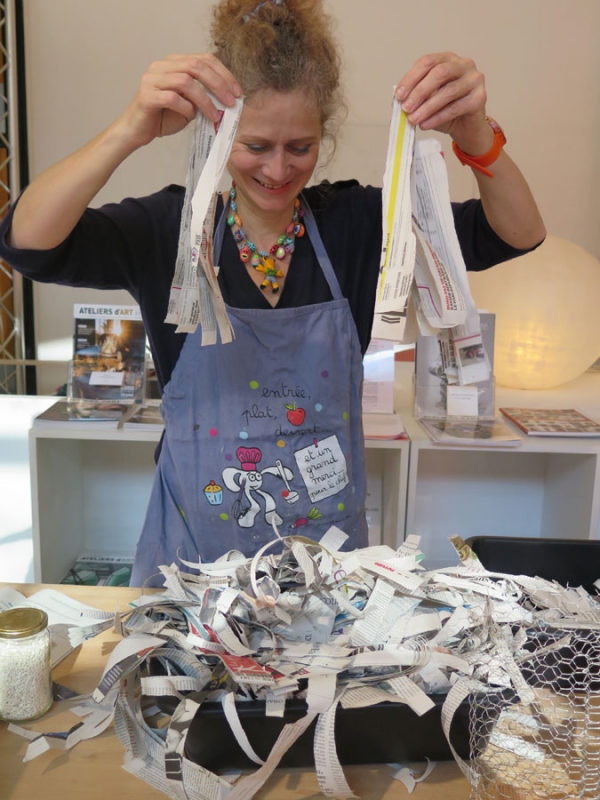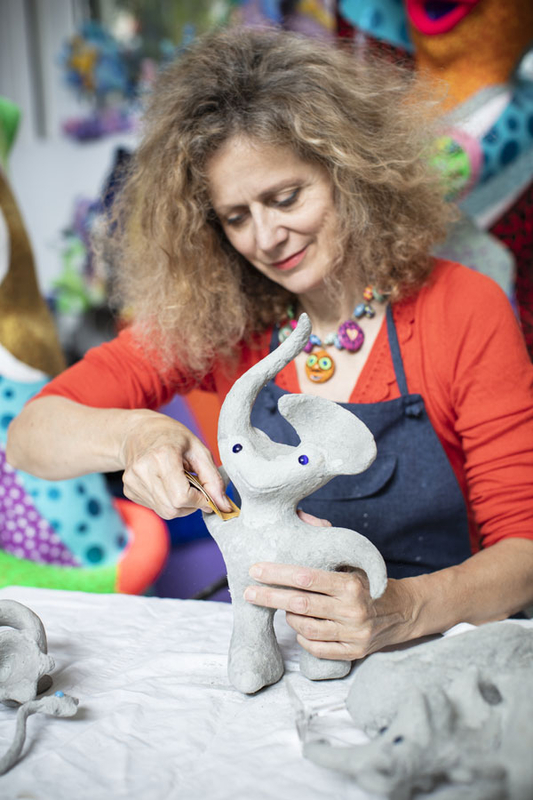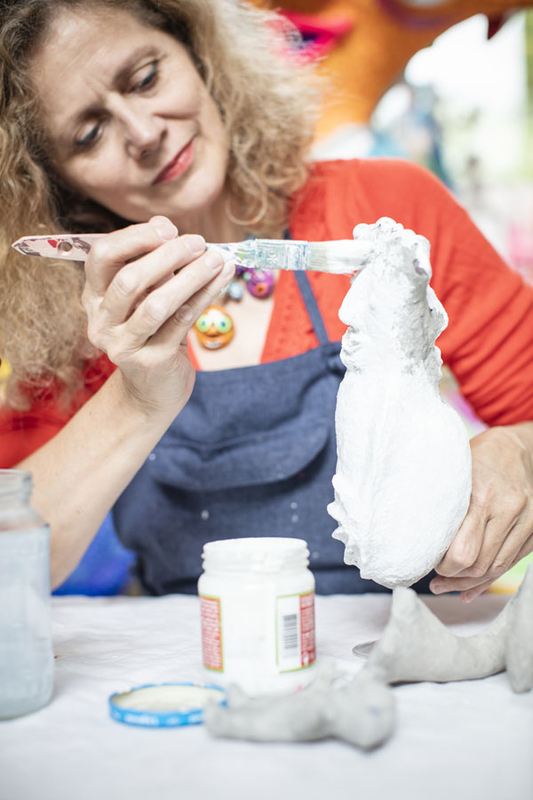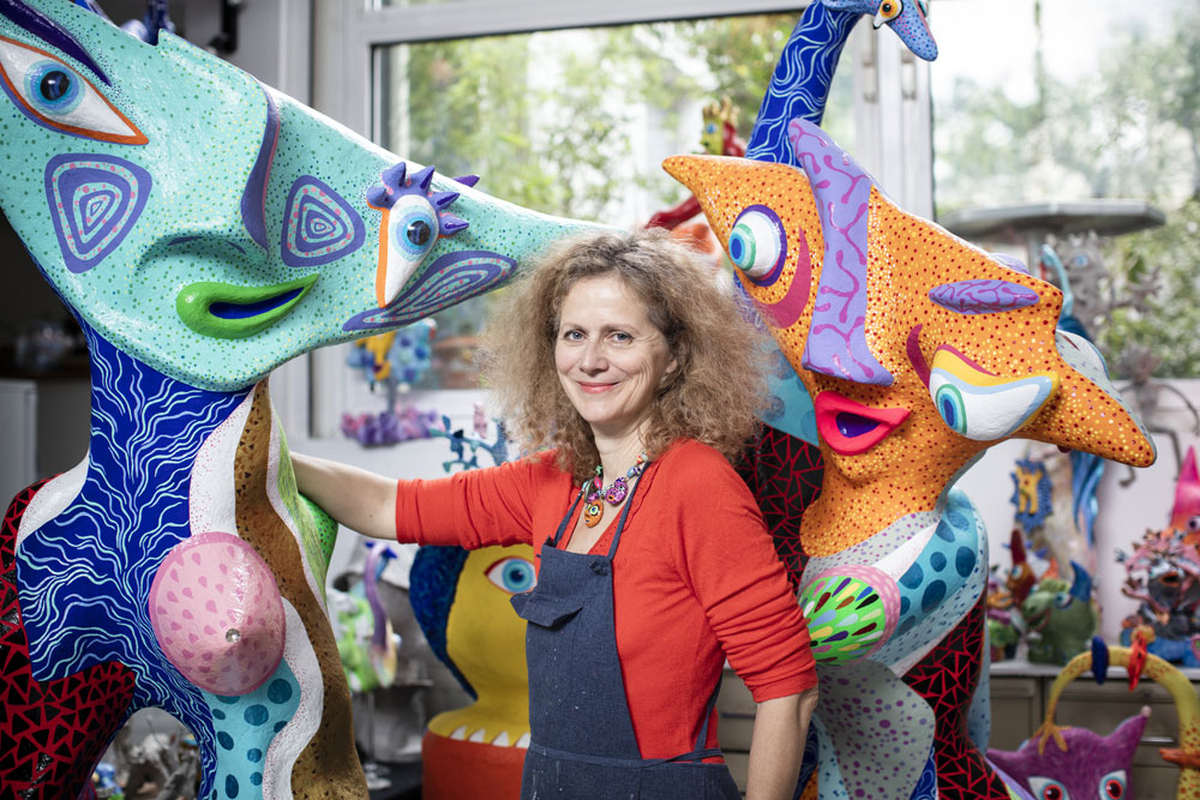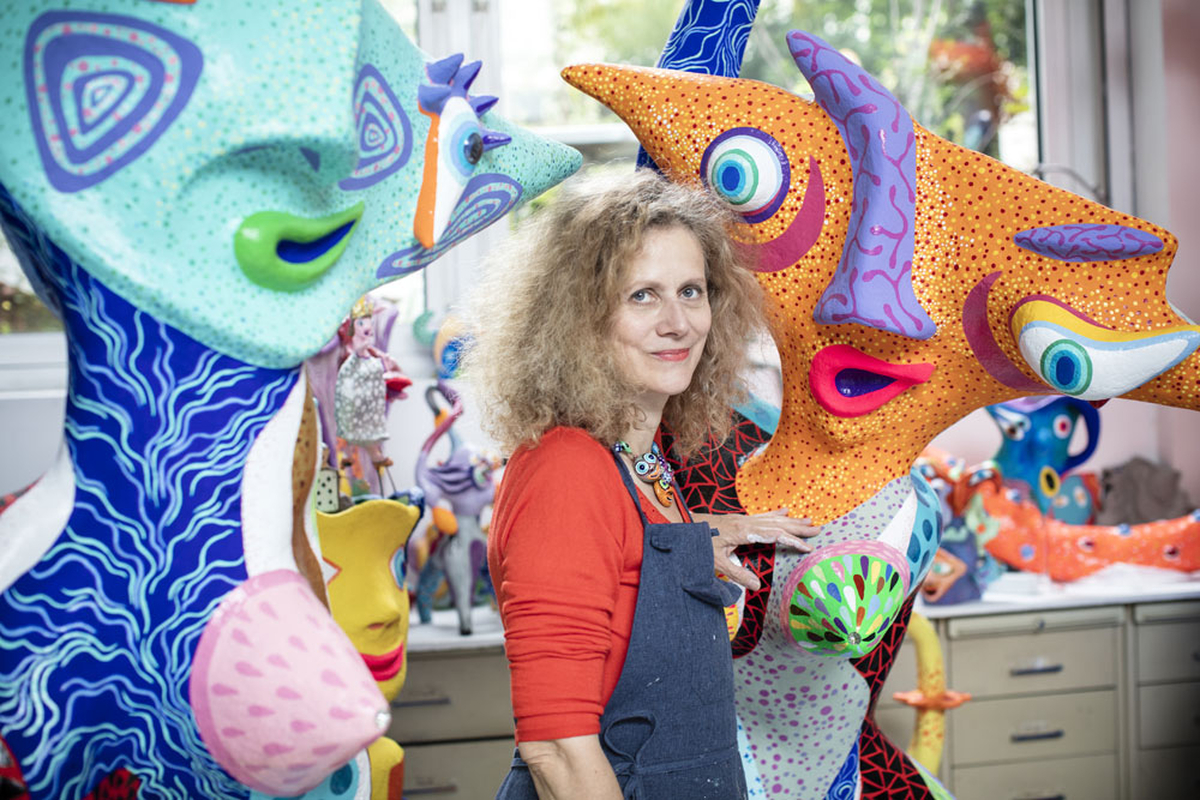PORTRAIT DE L’ARTISTE
English version below
MANÈGE ENCHANTÉ
Elle parle de « l’authenticité des gens qui font ça pour eux » lorsque je lui demande ce qui lui a donné envie d’embrasser une carrière d’artiste. Elle se souvient du vieux Monsieur Ferrara, un ancien docker, ami de la famille, quasiment aveugle, qui peignait des toiles naïves avec bonheur. Wabé se rappelle aussi la classe de travaux manuels, à l’école primaire : « le seul endroit où j’avais du plaisir, où l’ennui disparaissait. »
C’est là qu’elle a découvert, à onze ans, le papier mâché. « Un choc physique ». Dès lors, elle n’a eu de cesse de modeler, notamment des masques, au début. « Je n’avais de goût que pour cela. Tout le reste était une souffrance, tout le reste je le faisais à contre cœur. » À Marseille, les six enfants grandissaient autour du père, docker lui aussi, qui sculptait, peignait en amateur et collectionnait les magazines d’art d’occasion – « mes premières bandes dessinées. » La mère était musicienne. Elle écrivait et lisait beaucoup.
À vingt ans, c’est décidé : installée à Toulouse, Wabé abandonne l’étude de l’allemand – la langue de sa mère – pour l’histoire de l’art. Trois ans plus tard elle s’inscrit aux beaux-arts de Paris, où le peintre Cueco lui laisse « une paix royale ». La jeune femme prend pour pseudonyme ses initiales. Et le papier mâché entre en majesté. « Ma nourriture, mon pain quotidien, mon équilibre : je ne sais pas comment faire autrement. » À l’issue de moult expériences, le vocabulaire de Wabé se met en place. De ses doigts experts surgit irrémédiablement « un monde grouillant, animal ou humain mais pas végétal. » Vivant, mouvant, émouvant.
Des formes caractéristiques, ajourées et alvéolées, évoquant simultanément la liberté et la sécurité, s’imposent à chaque fois. La couleur les inonde, solaire, éclatante. Histoire de « satisfaire ma faim de ciel bleu. »
Tout ce qui naît dans l’atelier a fort à faire avec la métamorphose : assemblés en réseaux, les éléments qui constituent chaque sculpture semblent être tous un seul et même être, en fait. Comme si les motifs imaginés fixaient chacun un état fugace – saisi entre deux transformations incarnées par des réseaux serpentins – d’une même présence. Tout cela est issu « de rêves et de visions. C’est spontané au départ et ensuite, c’est très laborieux ».
Wabé se nourrit de voyages, de New York en Israël et jusqu’en Nouvelle Calédonie. Créer ? Réussir un cocktail, qui mêle « l’environnement et ma folie à moi. » Elle aime les contes du monde entier, signés Andersen, Grimm, Lewis Caroll ou encore anonymes, égrenés oralement par des griots africains. L’histoire de l’art lui est également précieuse : elle « vole des fragments » qui la touchent. Munie d’un appareil photographique, elle capture par exemple des détails du fameux triptyque La Tentation de Saint-Antoine de Jérôme Bosch (1453 – 1516).
Elle travaille beaucoup. Jusqu’à ce que la forme qui surgit acquiert « une cohérence. » Dans l’atelier, des bijoux – elle en a créé environ 3000 – jouxtent les maquettes de fontaines – celle réalisée en 2000 pour un square de Choisy-le-Roi par exemple – et d’autres monuments. Petite ou colossale, chacune de ces créations ouvre de grands yeux et montre bien les dents, comme pour nous indiquer la condition stupéfaite qui est la nôtre, face au mystère de nos existences.
Chacune de ces œuvres invite aussi à la caresse, tant ses courbes patiemment modelées sont souples. Les contempler donne envie d’écrire une nouvelle histoire de l’art, initiée par les vénus callipyges préhistoriques et rebondissant à travers les millénaires jusqu’à notre époque ; pour triompher du côté du Nouveau Réalisme de Niki de Saint-Phalle, de la Figuration Libre de Richard Di Rosa et des œuvres de Wabé, en passant par des trésors d’art populaire, mexicain ou japonais.
Sculptures ? Wabé préfère parler de « grigris à moi » ou encore de « petits gâteaux ». Sculpture ! Avec toujours « la peur au ventre de ne pas y arriver » depuis trente ans et tout en élevant trois filles Wabé retrousse ses manches toujours plus haut et affute sa sensibilité toujours plus profondément. Très loin des diktats minimalistes et conceptuels de l’art officiel, au bout du conte, elle fait du monde un manège enchanté. Intime et universel.
Françoise Monnin, Paris, octobre 2012
Les propos de l’artiste ont été recueillis dans son atelier, en juillet 2012.
ENCHANTED CARROUSEL
She speaks of « the authenticity of people who do it for themselves » when I ask what made her choose a career as an artist. With affection she remembers old Mr. Ferrara, a former docker, a family friend, almost blind, who painted naïve paintings with joy. Wabé also remembers her primary school years, during the classes of manual work, « the only place I found pleasure, where boredom disappeared. » It was in this class at age eleven, that she discovered papier mâché. It was « a physical shock. » Since then, she hasn’t stopped to invent, create and mold sculptures, notably masks at the start. « I had a taste for it. Everything else was like suffering, went against my heart. » In Marseille, the six children grew up around their father, also a docker, he carved, was an amateur painter and a collector of secondhand art magazines – « These were my first comics. » Her mother was a musician. She wrote and read a lot.
At twenty Wabé made a decision : she relocated in Toulouse, abandoned the study of German, her mother’s language, and took up the history of art. Three years later she enrolled in the Beaux-arts of Paris where the painter Cueco offered her « a royal tranquility. » The young woman fashioned her pseudonym from her initials. And the papier mâché grew majestically. « It was my food, my daily bread, my balance: I didn’t know how to do it differently. » After a multitude of experiences, Wabé’s vocabulary took form. From her unremitting expert fingers emerged « a swarming universe, animal and human but not vegetal. » Living, moving, emotive.
Characteristic forms, perforated, honeycombed and dimpled, simultaneously evoking freedom and security impose themselves every time. The colors imbue, radiate, solarize, and are brilliant. A way to « satisfy my craving for the blue sky. »
All that’s born in her studio has much to do with metamorphosis : assembled into networks, in fact, the mass of elements that make up each sculpture seem to all be one and the same being. As if the imagined motifs are each fixed in a fleeting state – captured between two transformations embodied in a snake-like lattice – from the same existence. All this arises « from dreams and visions. It’s spontaneous at the beginning and then is very arduous. »
Wabé has been fortified by voyages to New York and Israel or farther to New Caledonia. Create? Succeed in making a cocktail that combines both « the environment and my madness. » She loves tales from around the world written by Andersen, Grimm, Lewis Carroll, the anonymous, or uttered orally by African griots. The history of art itself is also a valuable source: she « purloins fragments » that touch and affect her. Equipped with a camera she captures details, such as facets from the famous triptych ‘The Temptation of St. Anthony’ by Hieronymus Bosch (1453-1516).
She works hard. Until the form that arises acquires a « coherence. » In the studio, there is also her jewelry – she has created around 3000 pieces – some sit adjacent to prototypes and models for fountains – one of which was completed in 2000 for a square in Choisy-le-Roi – and other monuments. Small or gigantic, all of her creations have large open eyes and show their teeth, as if to reveal the stupefied condition that is our own, facing the mystery of existence.
Each work invites us to caress, as the patiently shaped curves are smooth and curvilinear. Gazing on Wabé’s sculptures makes you want to write a new history of art, beginning from the origins of prehistoric calligraphy and then bouncing through the millennia to the present day; the Nouveau Realism of Niki de Saint-Phalle, the free figuration of Richard Di Rosa, the œuvres of Wabé, and the treasures of folk art from Mexico and Japan.
Sculpture? Wabé prefers to speak of « my gris-gris » or my « little cakes ». Sculpture! And always « the visceral fear of not succeeding ». Creating art for over thirty years while raising three daughters, today Wabé rolls her sleeves up even higher and continuously sharpens her sensitivity more profoundly. Far from the minimalist and conceptual dictates of official art, at the end of the tale, she turns the world into an enchanted carrousel. Intimate and universal.
Françoise Monnin, Paris, October 2012
Interview with the artist in her studio in July 2012.
English translation by Black Sifichi 2015

